Travel Through Malaysia on a Harley-Davidson
By Peter & Kay Forwood
Malaysia on a Harley (16/10/04 - 27/10/04)
Distance 1113 km (401553 km to 402666 km)
This is part of the eleventh section of our around
the world trip.
Complete Trip Overview & Map
Coming from Indonesia or read our previous
visit to Malaysia
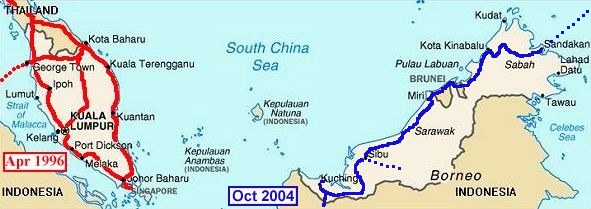 16/10/04 Entry to Malaysia also easy. A 30 day visa, free,
and no paperwork or customs check for the motorcycle. Land borders are so
much easier than shipping or flying. Instantly a different world. The roads,
roadsides, landscape neater. 100 km, one and a half hours to Kuching, the
capital of Sarawak. Kuching is set along the Sarawak River and has a well
developed promenade area with stalls and river boats, vastly in contrast to
Pontianak's ramshackle appeal.
16/10/04 Entry to Malaysia also easy. A 30 day visa, free,
and no paperwork or customs check for the motorcycle. Land borders are so
much easier than shipping or flying. Instantly a different world. The roads,
roadsides, landscape neater. 100 km, one and a half hours to Kuching, the
capital of Sarawak. Kuching is set along the Sarawak River and has a well
developed promenade area with stalls and river boats, vastly in contrast to
Pontianak's ramshackle appeal.
17/10/04 Kuching is a modern city but still runs it's
Sunday markets.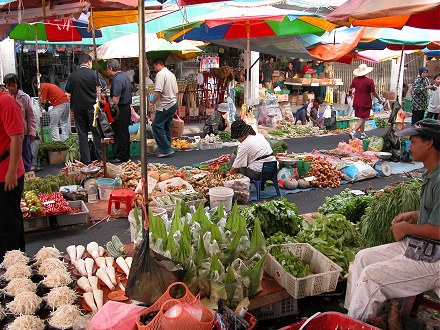 Primarily a fresh food market it sells everything the Malay and Chinese
cuisine demands that can be produced locally. Tropical fruits, leafy vegetables,
seafoods and meats, many we have not seen before, can't identify or begin
to think how to prepare them for eating. We have already eaten here foods
we can't identify, mixed in soups or fried. Catfish, crabs, sea snails, various
mushrooms, nuts, plant roots all end up in meals here. Bako National Park,
an hour north, then a 30 minute boat ride, is famous for the proboscis monkeys.
We headed out around lunch time, planning two nights, in park cabins, hoping
to see the monkeys. Being low tide we were put out of the boat in knee deep
water and carried our luggage across the sandy mud for 300 metres to shore.
Our bunkhouse, of four dormitory rooms, with a shared bathroom and kitchen
set back from the beach between rainforest trees, accessible by boardwalks.
The proboscis monkeys, which eat the leaves of mangroves, just a short boardwalk
away. Ten minutes walk and there were three, eating leaves, resting and rambling
between mangroves across the mud flats, low tide. Further along the trail
a larger group of perhaps 20, a big male, females and juveniles, straddled
the track high in the trees.
Primarily a fresh food market it sells everything the Malay and Chinese
cuisine demands that can be produced locally. Tropical fruits, leafy vegetables,
seafoods and meats, many we have not seen before, can't identify or begin
to think how to prepare them for eating. We have already eaten here foods
we can't identify, mixed in soups or fried. Catfish, crabs, sea snails, various
mushrooms, nuts, plant roots all end up in meals here. Bako National Park,
an hour north, then a 30 minute boat ride, is famous for the proboscis monkeys.
We headed out around lunch time, planning two nights, in park cabins, hoping
to see the monkeys. Being low tide we were put out of the boat in knee deep
water and carried our luggage across the sandy mud for 300 metres to shore.
Our bunkhouse, of four dormitory rooms, with a shared bathroom and kitchen
set back from the beach between rainforest trees, accessible by boardwalks.
The proboscis monkeys, which eat the leaves of mangroves, just a short boardwalk
away. Ten minutes walk and there were three, eating leaves, resting and rambling
between mangroves across the mud flats, low tide. Further along the trail
a larger group of perhaps 20, a big male, females and juveniles, straddled
the track high in the trees.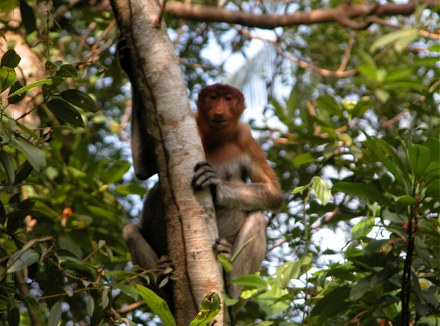 Cautiously they moved around us leaping from one tree to the next, not
frightened but never getting closer than about 15 metres. The park canteen
provided a good meal and we watched an evening video on the proboscis monkey
and other wildlife in the park.
Cautiously they moved around us leaping from one tree to the next, not
frightened but never getting closer than about 15 metres. The park canteen
provided a good meal and we watched an evening video on the proboscis monkey
and other wildlife in the park.
18/10/04 The cabin/admin area is a haven for some of the
parks animals. Squirrel, macaque monkeys, snakes, lizards and the bearded
pigs wander through the area. We teamed up with a couple of other travellers
for the 5 km loop walk. Through rainforest, wooded savannah then more rainforest.
Despite our early morning start animals were hard to spot. The insectivorous
pitcher plants dotted the dryer areas. All different sizes up to 12 cm deep
and four cm across the trap door lid. The park, although popular, only attracts
about 60 people a day giving it a wilderness feel along the trails. Most came
only for the proboscis monkey and only walk that trail. In the evening we
walked to a lookout, spotting a solitary male proboscis monkey, and overlooked
the beach and park admin area.
19/10/04 We decided to stay another night, relax here
rather than in Kuching. Before dawn we headed towards the large group of
proboscis we had seen before. They were still resting, sitting close together
in the one tree. Macaque monkeys started taunting them to verbal abuse but
slowly moved on. The proboscis started feeding, jumping to an adjoining tree.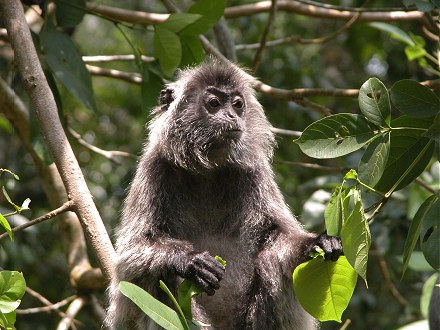 Two adolescent males had a confrontation, dancing between branches, facing
off and generally scaring the females and young to the trees edges. The
dominant male, not phased, kept grazing. We watched their antics for over
an hour before returning to the camp for breakfast, washing, writing diaries
and relaxing. Later in the afternoon a troupe of about 30 silver langur monkeys
moved through camp slowly eating, mainly vine leaves. Later a troop of macaques,
aggressive and taunting people for food, attempted to raid the cabins through
open windows or doors.
Two adolescent males had a confrontation, dancing between branches, facing
off and generally scaring the females and young to the trees edges. The
dominant male, not phased, kept grazing. We watched their antics for over
an hour before returning to the camp for breakfast, washing, writing diaries
and relaxing. Later in the afternoon a troupe of about 30 silver langur monkeys
moved through camp slowly eating, mainly vine leaves. Later a troop of macaques,
aggressive and taunting people for food, attempted to raid the cabins through
open windows or doors.
20/10/04 The peak of the wet season is rapidly approaching.
It rained overnight and this morning. Boat and bike ride back to Kuching.
A better hotel than the one we stayed in last time as it had had bed bugs,
the bites are still itchy. We worked through the photos taken in the park
using the lap top to view them. The limitations of our digital photos is
in poor light, particularly with moving subjects. The slower shutter speed
needed in the rainforest produced a blurred image in the best motion shots.
However we did manage a few reasonable photos. Internet and evening dinner
with some people we met in the park. Food here amazingly varied.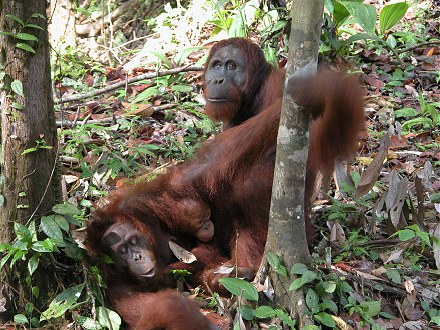
21/10/04 Semenggoh Wildlife Rehabilitation Centre, 21
km from Kuching, rehabilitates mainly orang-utan apes. They now have 22,
with about half having been born there. They are fed a minimum diet hoping
they will start to forage in the natural rainforest for the majority of their
diet. Some have completely returned to the wild and haven't come down for
a feed in years. Others come almost every day for the supplement, particularly
this time of year when the forest fruits are more scarce. We arrived at 8.00
am, an hour before feeding and were rewarded with four orang-utan milling
around the compound waiting for the 9.00 am feed. Gibbon monkeys are also
rehabilitated here, 40 are now living in the wild, however a five year old
was already too humanized on arrival and will most likely never be able to
return to the wild. He puts on a friendly personality display, almost stealing
the show from his bigger cousins. The tour groups arrived just in time for
feeding and a total of six orang-utan came to the feeding platform. The dominant
male did not show however another adult male was present and mated with a
female with a large baby, much to the surprise of the tourists. The relaxed
event in front of flashing cameras taking some minutes. We returned to Kuching
to plan the next section of our trip.
22/10/04 Kuching's modern history goes back to the British
adventurer, Brooks, who ended up owning and controlling a large part of
Sarawak with his family for over 100 years till the second world war. They
built the Kuching Museum which houses hundreds of stuffed animals from the
region, now 100 years old themselves. They also collected native artefacts,
masks, weapons and tools. The current government maintains the displays and
has added new ones to the original building. We visited the museum, had our
photos burned to CD for safer storage, available in internet shops or camera
shops everywhere, and enjoyed more good food.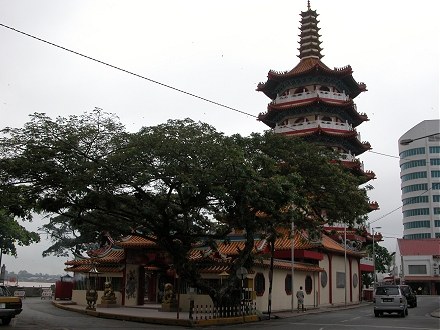
23/10/04 The motorcycle is still a worry with substantial
amounts of oil moving somehow from the primary (clutch) to the engine, draining
one and flooding the other chamber. We emailed the H-D dealer in Brisbane,
Morgan and Wacker and their workshop supervisor advised some possible causes.
For three hours we looked into the possible causes, on the footpath outside
our hotel. We noticed the new oil seal we had installed in Australia had moved,
shifted outwards, perhaps running in the groove of the spacer which we hadn't
replaced. Knocked the seal back in and using ten minute araldite (glue) hopefully
it will remain in place, and seal. 420 km, Kuching to Sibu, pothole free
but speed often limited due to the bouncy road, the road base shifting in
the wet conditions. Sparsely populated, logged of useful timbers, regrowth
occurring with vines. Some agriculture but not much. A ferry across the Rejang
River, the transport artery to the indigenous people inland and a popular
excursion with tourists. A different town from Kuching, more locals, less
Chinese influence. Evening markets in the main square occupied us till bedtime.
24/10/04 A seven storied Taoist Pagoda sits alongside
the river bank in its glorious colours of red and gold, guarded by two concrete
curly haired lions and many dragons.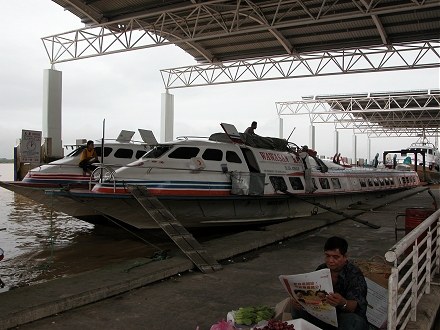 The caretaker spent half an hour with us, as he does with any tourists
in town, describing in detail the Confucius beliefs, Yin and Yen, Tai Chee
and their connections with the modern world and good luck. Afterwards we
climbed to the top level for great views over the city and river. It's the
wet season and we have so far avoided its downpours. Yesterday we huddled
in a bus stop for 45 minutes while a tropical thunderstorm passed. This morning
it was raining steadily. The police station allowed us to park the motorcycle
in their compound while we caught a long river fast boat up to Kapit. A town
120 km up river, no road access. Three hours dodging floating debris, hitting
a few smaller logs with hollow clanging sounds against the metal hull. The
banks logged of valuable timbers, left with regrowth and low jungle. Logs
piled high on the banks or floating tied together ready for the downstream
sawmills. Foreigners have been in this area for a long time. The Chinese before
Brooks who built Kapit fort to pacify warring local tribes. Trade up and
down the river for over 200 years in recent history. We stayed here the night
not wishing to go further up river and will return to Sibu tomorrow.
The caretaker spent half an hour with us, as he does with any tourists
in town, describing in detail the Confucius beliefs, Yin and Yen, Tai Chee
and their connections with the modern world and good luck. Afterwards we
climbed to the top level for great views over the city and river. It's the
wet season and we have so far avoided its downpours. Yesterday we huddled
in a bus stop for 45 minutes while a tropical thunderstorm passed. This morning
it was raining steadily. The police station allowed us to park the motorcycle
in their compound while we caught a long river fast boat up to Kapit. A town
120 km up river, no road access. Three hours dodging floating debris, hitting
a few smaller logs with hollow clanging sounds against the metal hull. The
banks logged of valuable timbers, left with regrowth and low jungle. Logs
piled high on the banks or floating tied together ready for the downstream
sawmills. Foreigners have been in this area for a long time. The Chinese before
Brooks who built Kapit fort to pacify warring local tribes. Trade up and
down the river for over 200 years in recent history. We stayed here the night
not wishing to go further up river and will return to Sibu tomorrow.
25/10/04 Three hours back down the river, collected the
motorcycle from the police compound and 230 km to Bintulu. Again a fast
but bouncy road.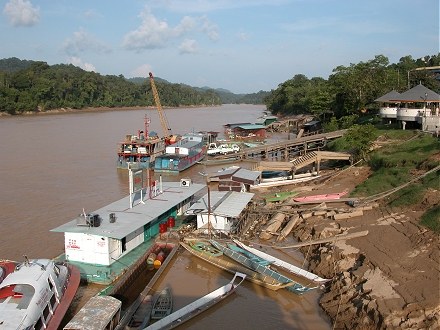 The major river crossings had logging camps, sawmills or plywood factories
processing enormous quantities of timber brought down each river from inland,
the largest industry in this region. Whilst Ramadan, the muslim fasting
month, started ten days ago, we have not observed any restrictions in our
ability to find restaurants open or other people eating during daylight hours,
forbidden for Muslims at this time. The high percentage of non Muslims in
Sarawak (Christians and Taoists) continue life as normal. Gambling and drinking
alcohol. Bintulu is another upriver supply town like Sibu. This trade brings
prosperity, supply of western goods and processing timber. Boats run regularly
up and down, the only access.
The major river crossings had logging camps, sawmills or plywood factories
processing enormous quantities of timber brought down each river from inland,
the largest industry in this region. Whilst Ramadan, the muslim fasting
month, started ten days ago, we have not observed any restrictions in our
ability to find restaurants open or other people eating during daylight hours,
forbidden for Muslims at this time. The high percentage of non Muslims in
Sarawak (Christians and Taoists) continue life as normal. Gambling and drinking
alcohol. Bintulu is another upriver supply town like Sibu. This trade brings
prosperity, supply of western goods and processing timber. Boats run regularly
up and down, the only access.
26/10/04 130 km's to Niah Cave, one of the world's largest.
A three km long rickety boardwalk from the park entrance to the cave mouth.
People have been living here for 40,000 years. Back in the 1960's four million
swiftlets (swallows) nested and roosted in the caves. Today less than 10%
remain. They and the insectivorous bats still manage to deposit over a ton
of guano (shit) each day on the cave floor. The guano is collected by locals
and sold in the markets as fertilizer. Over 1000 years ago the Chinese started
trading for the swiftlet's nests, made from the bird's saliva. The nests are
built high up in the most remote corners and tunnels of the cave.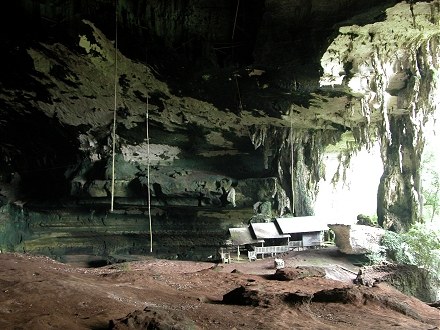 Suspended from the ceiling are long blackwood poles, joined by wooden nails,
dangling down to the cave floor, man's only access to the nests. At this
time of year locals climb these poles to collect the first nests of the swiftlets,
the most sought after can reach $US 1000 a kilogram. The birds are then allowed
to raise chicks in new nests which are later collected in April. The high
price brings poachers and during our visit a couple scurried about in the
darkness with their shorter demountable poles avoiding our camera. The boardwalk
passes a 1950's archaeological dig, through the cave and onto another cave
where faded paintings are on the wall and the remains of wooden burial boats
can be seen. We waited almost till sunset and watched the bats leave for their
evening feed, walking the boardwalk in darkness.
Suspended from the ceiling are long blackwood poles, joined by wooden nails,
dangling down to the cave floor, man's only access to the nests. At this
time of year locals climb these poles to collect the first nests of the swiftlets,
the most sought after can reach $US 1000 a kilogram. The birds are then allowed
to raise chicks in new nests which are later collected in April. The high
price brings poachers and during our visit a couple scurried about in the
darkness with their shorter demountable poles avoiding our camera. The boardwalk
passes a 1950's archaeological dig, through the cave and onto another cave
where faded paintings are on the wall and the remains of wooden burial boats
can be seen. We waited almost till sunset and watched the bats leave for their
evening feed, walking the boardwalk in darkness.
27/10/04 It would seem we have solved the oil problem
with the bike. Almost 1000 km and no noticeable movement of oil from primary
to engine. We rode straight to the border, past plantations of palm oil.
This mono culture replacing the diversified rain forests. Five minutes at
immigration, no customs and we left Malaysia.
Move with us to Brunei
, or go to our next visit to Malaysia.
 16/10/04 Entry to Malaysia also easy. A 30 day visa, free,
and no paperwork or customs check for the motorcycle. Land borders are so
much easier than shipping or flying. Instantly a different world. The roads,
roadsides, landscape neater. 100 km, one and a half hours to Kuching, the
capital of Sarawak. Kuching is set along the Sarawak River and has a well
developed promenade area with stalls and river boats, vastly in contrast to
Pontianak's ramshackle appeal.
16/10/04 Entry to Malaysia also easy. A 30 day visa, free,
and no paperwork or customs check for the motorcycle. Land borders are so
much easier than shipping or flying. Instantly a different world. The roads,
roadsides, landscape neater. 100 km, one and a half hours to Kuching, the
capital of Sarawak. Kuching is set along the Sarawak River and has a well
developed promenade area with stalls and river boats, vastly in contrast to
Pontianak's ramshackle appeal.  Primarily a fresh food market it sells everything the Malay and Chinese
cuisine demands that can be produced locally. Tropical fruits, leafy vegetables,
seafoods and meats, many we have not seen before, can't identify or begin
to think how to prepare them for eating. We have already eaten here foods
we can't identify, mixed in soups or fried. Catfish, crabs, sea snails, various
mushrooms, nuts, plant roots all end up in meals here. Bako National Park,
an hour north, then a 30 minute boat ride, is famous for the proboscis monkeys.
We headed out around lunch time, planning two nights, in park cabins, hoping
to see the monkeys. Being low tide we were put out of the boat in knee deep
water and carried our luggage across the sandy mud for 300 metres to shore.
Our bunkhouse, of four dormitory rooms, with a shared bathroom and kitchen
set back from the beach between rainforest trees, accessible by boardwalks.
The proboscis monkeys, which eat the leaves of mangroves, just a short boardwalk
away. Ten minutes walk and there were three, eating leaves, resting and rambling
between mangroves across the mud flats, low tide. Further along the trail
a larger group of perhaps 20, a big male, females and juveniles, straddled
the track high in the trees.
Primarily a fresh food market it sells everything the Malay and Chinese
cuisine demands that can be produced locally. Tropical fruits, leafy vegetables,
seafoods and meats, many we have not seen before, can't identify or begin
to think how to prepare them for eating. We have already eaten here foods
we can't identify, mixed in soups or fried. Catfish, crabs, sea snails, various
mushrooms, nuts, plant roots all end up in meals here. Bako National Park,
an hour north, then a 30 minute boat ride, is famous for the proboscis monkeys.
We headed out around lunch time, planning two nights, in park cabins, hoping
to see the monkeys. Being low tide we were put out of the boat in knee deep
water and carried our luggage across the sandy mud for 300 metres to shore.
Our bunkhouse, of four dormitory rooms, with a shared bathroom and kitchen
set back from the beach between rainforest trees, accessible by boardwalks.
The proboscis monkeys, which eat the leaves of mangroves, just a short boardwalk
away. Ten minutes walk and there were three, eating leaves, resting and rambling
between mangroves across the mud flats, low tide. Further along the trail
a larger group of perhaps 20, a big male, females and juveniles, straddled
the track high in the trees. Cautiously they moved around us leaping from one tree to the next, not
frightened but never getting closer than about 15 metres. The park canteen
provided a good meal and we watched an evening video on the proboscis monkey
and other wildlife in the park.
Cautiously they moved around us leaping from one tree to the next, not
frightened but never getting closer than about 15 metres. The park canteen
provided a good meal and we watched an evening video on the proboscis monkey
and other wildlife in the park.  Two adolescent males had a confrontation, dancing between branches, facing
off and generally scaring the females and young to the trees edges. The
dominant male, not phased, kept grazing. We watched their antics for over
an hour before returning to the camp for breakfast, washing, writing diaries
and relaxing. Later in the afternoon a troupe of about 30 silver langur monkeys
moved through camp slowly eating, mainly vine leaves. Later a troop of macaques,
aggressive and taunting people for food, attempted to raid the cabins through
open windows or doors.
Two adolescent males had a confrontation, dancing between branches, facing
off and generally scaring the females and young to the trees edges. The
dominant male, not phased, kept grazing. We watched their antics for over
an hour before returning to the camp for breakfast, washing, writing diaries
and relaxing. Later in the afternoon a troupe of about 30 silver langur monkeys
moved through camp slowly eating, mainly vine leaves. Later a troop of macaques,
aggressive and taunting people for food, attempted to raid the cabins through
open windows or doors. 

 The caretaker spent half an hour with us, as he does with any tourists
in town, describing in detail the Confucius beliefs, Yin and Yen, Tai Chee
and their connections with the modern world and good luck. Afterwards we
climbed to the top level for great views over the city and river. It's the
wet season and we have so far avoided its downpours. Yesterday we huddled
in a bus stop for 45 minutes while a tropical thunderstorm passed. This morning
it was raining steadily. The police station allowed us to park the motorcycle
in their compound while we caught a long river fast boat up to Kapit. A town
120 km up river, no road access. Three hours dodging floating debris, hitting
a few smaller logs with hollow clanging sounds against the metal hull. The
banks logged of valuable timbers, left with regrowth and low jungle. Logs
piled high on the banks or floating tied together ready for the downstream
sawmills. Foreigners have been in this area for a long time. The Chinese before
Brooks who built Kapit fort to pacify warring local tribes. Trade up and
down the river for over 200 years in recent history. We stayed here the night
not wishing to go further up river and will return to Sibu tomorrow.
The caretaker spent half an hour with us, as he does with any tourists
in town, describing in detail the Confucius beliefs, Yin and Yen, Tai Chee
and their connections with the modern world and good luck. Afterwards we
climbed to the top level for great views over the city and river. It's the
wet season and we have so far avoided its downpours. Yesterday we huddled
in a bus stop for 45 minutes while a tropical thunderstorm passed. This morning
it was raining steadily. The police station allowed us to park the motorcycle
in their compound while we caught a long river fast boat up to Kapit. A town
120 km up river, no road access. Three hours dodging floating debris, hitting
a few smaller logs with hollow clanging sounds against the metal hull. The
banks logged of valuable timbers, left with regrowth and low jungle. Logs
piled high on the banks or floating tied together ready for the downstream
sawmills. Foreigners have been in this area for a long time. The Chinese before
Brooks who built Kapit fort to pacify warring local tribes. Trade up and
down the river for over 200 years in recent history. We stayed here the night
not wishing to go further up river and will return to Sibu tomorrow.
 The major river crossings had logging camps, sawmills or plywood factories
processing enormous quantities of timber brought down each river from inland,
the largest industry in this region. Whilst Ramadan, the muslim fasting
month, started ten days ago, we have not observed any restrictions in our
ability to find restaurants open or other people eating during daylight hours,
forbidden for Muslims at this time. The high percentage of non Muslims in
Sarawak (Christians and Taoists) continue life as normal. Gambling and drinking
alcohol. Bintulu is another upriver supply town like Sibu. This trade brings
prosperity, supply of western goods and processing timber. Boats run regularly
up and down, the only access.
The major river crossings had logging camps, sawmills or plywood factories
processing enormous quantities of timber brought down each river from inland,
the largest industry in this region. Whilst Ramadan, the muslim fasting
month, started ten days ago, we have not observed any restrictions in our
ability to find restaurants open or other people eating during daylight hours,
forbidden for Muslims at this time. The high percentage of non Muslims in
Sarawak (Christians and Taoists) continue life as normal. Gambling and drinking
alcohol. Bintulu is another upriver supply town like Sibu. This trade brings
prosperity, supply of western goods and processing timber. Boats run regularly
up and down, the only access.  Suspended from the ceiling are long blackwood poles, joined by wooden nails,
dangling down to the cave floor, man's only access to the nests. At this
time of year locals climb these poles to collect the first nests of the swiftlets,
the most sought after can reach $US 1000 a kilogram. The birds are then allowed
to raise chicks in new nests which are later collected in April. The high
price brings poachers and during our visit a couple scurried about in the
darkness with their shorter demountable poles avoiding our camera. The boardwalk
passes a 1950's archaeological dig, through the cave and onto another cave
where faded paintings are on the wall and the remains of wooden burial boats
can be seen. We waited almost till sunset and watched the bats leave for their
evening feed, walking the boardwalk in darkness.
Suspended from the ceiling are long blackwood poles, joined by wooden nails,
dangling down to the cave floor, man's only access to the nests. At this
time of year locals climb these poles to collect the first nests of the swiftlets,
the most sought after can reach $US 1000 a kilogram. The birds are then allowed
to raise chicks in new nests which are later collected in April. The high
price brings poachers and during our visit a couple scurried about in the
darkness with their shorter demountable poles avoiding our camera. The boardwalk
passes a 1950's archaeological dig, through the cave and onto another cave
where faded paintings are on the wall and the remains of wooden burial boats
can be seen. We waited almost till sunset and watched the bats leave for their
evening feed, walking the boardwalk in darkness.